This is Braj, the land where Krishna — the last of the nine avatars of Vishnu —
The 21st-century Vrindavan has neither any vrinda (tulsi) nor any van (forest). The forest has given way to a sea of unplanned development, rampant land-grabbing and a material corruption that has successfully invaded the very soul of this 5,000-strong temple city. The gopas (cowherds) have been replaced by goons, moneyextorting hoodlums in the garb of guides; the pundits in the temples have turned into brokers. And the gopis are nowhere to be seen — not one girl above 15, and not one woman below 35 walks here; those who do are tourists. And the Yamuna River, once the source of many cities, towns and ashrams, has been forced to meander about 50-100 yards away from its main course, choked by garbage and rubble. The extent of the decay is visible: the ground floor of Emperor Akbar’s mansion has been swallowed completely and the ground now begins from the first floor.

Where is Krishna? Now a more apt question would be ‘when’, not ‘where’. The answer: Between 6 and 7.30 pm. That’s when you hear the sublime and uplifting clangs of temple bells, as every temple begins its evening aarti. The whole town wakes up to a joyous celebration. Each clang knocks at the soul, cleansing it of all frustration, all danger, all disappointment. Everything is in harmony, there is only oneness — each body a part of one spirit. Krishna’s final message to Arjun — “Forsaking all other dharmas, remember Me alone” — can be experienced in one temple after another through an infectious surrendering. As the clangs ring shrill, you can clearly differentiate the duality of tourists (who gape open-mouthed) from the unity of the locals, who are completely integrated, men, animals, statues, bells… Peace.
THINGS TO SEE AND DO
Of course, it is the temples that the pilgrims come to visit. As a result, in an economy devoid of opportunities, temples have become the biggest industry. Making matters worse is a brand called prachin mandir (ancient temple), implanted on temples that are less than two years old. The truly prachin mandirs are just seven — Baanke Bihari, Gokulananda, Gopinath, Govindadeva, Madan Mohanji, Radha Damodar and Radha Shyamsunder and they are a must for every devotee. Walking is the best way of getting around in Vrindavan and it’s unlikely you will need more than two nights and three days here.
The Prachin Mandirs
A pundit who looks as old as the decrepit high building he stands on claims that Madan Mohanji, currently being renovated by ASI, is Vrindavan’s oldest temple. Old or new, as you climb its steps, you can feel the presence of a rich and inspiring past. As he moves within its ruins, he claims this building was constructed in 516 CE, though 1580 would be more realistic. But it doesn’t really matter: In this quiet, high corner of Vrindavan, Krishna embraces you in silence.

Apart from the statues of Krishna in the quaint Radha Damodaran Temple, you will find many small samadhis of saints. Most of these belong to Goswamis (saints), seven of whom would do the Govardhan parikrama (a walk of more than 35 km) everyday. Pleased with Jiva Goswami’s bhakti, it is said, Krishna gave him a darshan in his dreams. And the stone on which Krishna stood still carries his footprints, along with the hoofmark of a cow. But to see it, you need to give a donation. It is said that when Mirabai sought audience with Jiva Goswami, he refused, giving his celibacy as a reason, at which Mirabai chided him and enlightened him that there is only one male — Krishna. Today, as good neighbours, the small but sweet Mirabai Temple, humble in its design, is just across the road from Jiva’s samadhi. The ancient, three-storeyed, brick-coloured Govindadeva Temple is architecturally delightful. It is believed that there were seven storeys when Raja Man Singh completed it in 1590. The top of the temple could be seen from as far away as Jaipur. It is said that when Mirabai came to Vrindavan, it was in Govindadeva that she found her Krishna.
Other Temples
Besides the prachin mandirs, there are two others that attract many devotees. Rangji, constructed in 1851, is a huge temple compound that contains many smaller temples. It is laid out in sublime symmetry, with each small temple a part of a larger whole. Here you get to see, for a nominal fee, the Sone ki Palki and a set of eight vehicles — elephants, horses, chariots — made of gold or silver covered by a thick layer of dust. In their prime they must have radiated the lustre that a god’s vehicle ought to. The ISKCON Temple is the first temple you see as you enter Vrindavan. It is white in more ways than you think — both the building and the people manning it.
The Ghats

For those seeking to find Krishna in the silence of this holy space, the ghats are without doubt the sole destination. You can sit here for hours on a winter afternoon, watching the waters flow by and the only sounds that break the silence are the splashing of waters as turtles come up for air or the drone of a pandit sitting on the ghat, reciting his wisdom. Walk the river, beginning from Suraj Ghat, through Chir Ghat and finally to the Kesi Ghat that ends just short of a pontoon bridge over the river. Cross over and see Vrindavan from a different perspective. Some ecologists believe that Krishna was the first environmentalist and the driving away — not the slaying — of Kalia is a metaphor of removing pollution from the river.
Ras Leela
In case you’re visiting in February- March, don’t miss the Ras Leela Festival, during which the ras dance — which Lord Krishna used to perform at Gokul and Vrindavan — is performed. It involves young people moving in measured steps around a circle, accompanied by a singing chorus and musical instruments.
SHOPPING
What do you carry home from a city that has nothing but sentimental intangibles to offer? Portraits and mini statues of Krishna? The scores of clothes made for his various forms? Malas? Books? All this and more are available in abundance in Vrindavan’s bazaars. But the two things I would particularly recommend are a tulsi bead mala for between ₹15-25 apiece, and bells (₹ 250 a kg — a good sized bell would be about 2.5-3 kg). Near the Janmasthan in Mathura is Brijwasi, a shop that makes the world’s most delicious pedhas for ₹200 a kg.
WHERE TO STAY
Mathura has several options. The swanky ones are Best Western Radha Ashok (Tel: 0565-2530395-96; Tariff: ₹3,600-7,500), Brijwasi Royal (Tel: 2401224-26; Tariff: ₹2,350-4,350) and Hotel Abhinandan (Tel: 2422290, 2423213; Tariff: ₹2,250-3,350). Madhuvan (Tel: 2420058/ 64; Tariff: ₹2,900-4,200) and Mansarovar Palace (Tel: 2408686; Tariff: ₹1,050-1,550), near the station, are decent hotels. In Vrindavan, forget about luxury. And be prepared to retire by 9 pm; it’s not safe to venture out after that. There are many ashrams with accommodation here. Vrindavan also has the much booked, tasteful MVT Guesthouse (Tel: 0565-3207578-79; Tariff: ₹975), near the ISKCON Temple. For more, see Vrindavan Accommodation Listings on pages 1128-1130
WHERE TO EAT
Mathura and Vrindavan are both mainly dhaba-type places. In Mathura, if you stay in an expensive hotel, the inhouse restaurant should do the trick for you. The International Guesthouse next to the Krishna Janmabhoomi gives a nice thali with items cooked in ghee. The dhabas in front of the temple gate offer cheap, okay food. The dhabas near Vishram Ghat are more interesting, catering as they do to various ethnicities of tourists. Outlets of Brijwasi sell the most delicious pedhas for ₹200 a kg. They make great gifts back home since Mathura is famous for pedhas. Vrindavan has dhabas which offer cheap food but are not very clean. However, the MVT Guesthouse Cafetaria (12.30-3 pm and 6.30-8.30 pm), near ISKCON Temple, is outstanding. They give a great veg thali, lasagna, pizza and cheesecake. The ISKCON canteen, Govinda (open 9.30 am-3 pm, 7-9 pm), also serves a very sumptuous veg thali. No non-veg food or booze in Vrindavan.
Vrindavan
culture
Pilgrimages





